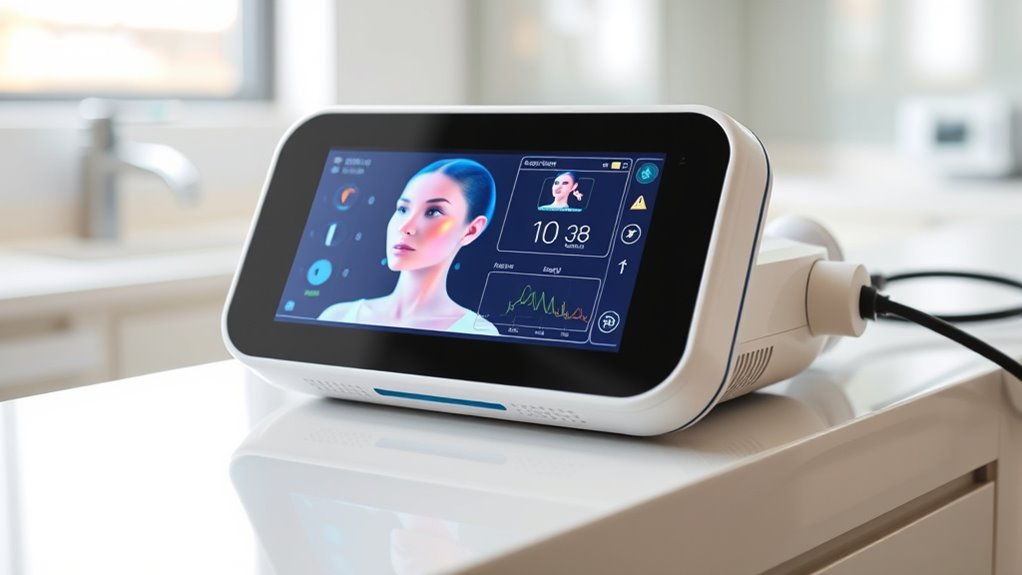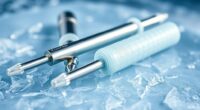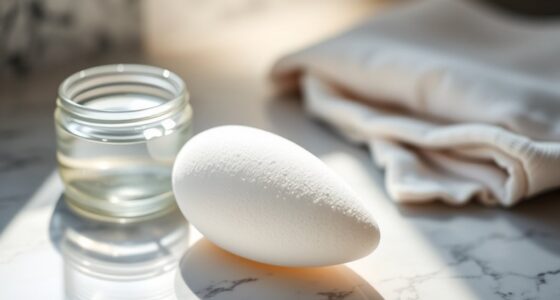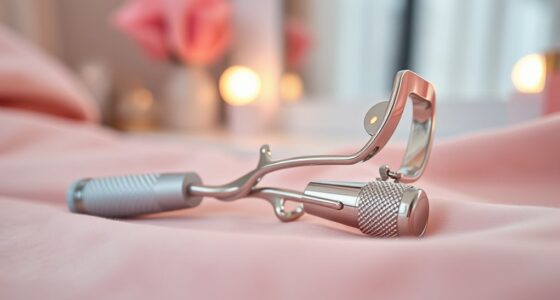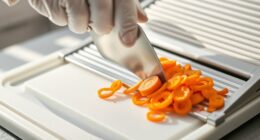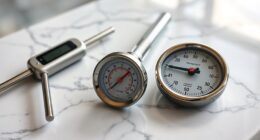To check the accuracy of your skin analyzer device, guarantee it’s properly calibrated using standard skin simulators or reference samples as recommended by the manufacturer. Regular calibration helps maintain measurement consistency and prevents errors that could affect your skin type classification or attribute readings. Environmental factors like lighting, humidity, and temperature also influence results. Staying aware of calibration status and device maintenance is key. Continue exploring to learn how to optimize your device’s performance for precise skincare insights.
Key Takeaways
- Regular calibration with standard skin simulators ensures measurement accuracy of skin attribute readings.
- Using manufacturer-recommended calibration procedures maintains device reliability and correct skin type classification.
- Environmental conditions like lighting and humidity can impact measurement accuracy, requiring controlled settings.
- Self-calibration features in modern devices help improve ongoing measurement consistency and trustworthiness.
- Periodic professional calibration may be necessary for advanced devices to verify and adjust measurement precision.
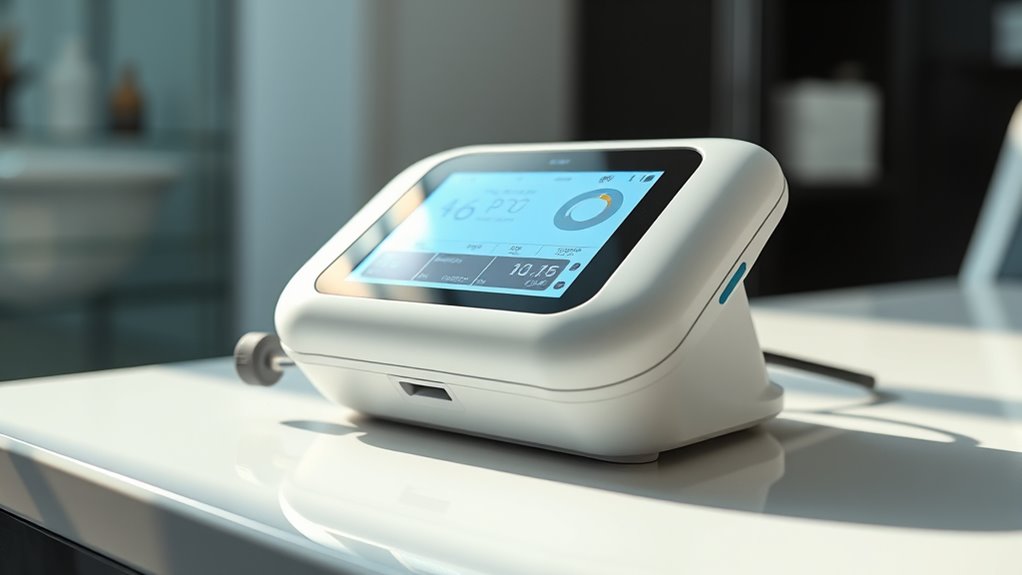
Skin analyzer devices have become essential tools for anyone looking to understand their skin better. When you’re exploring different products or treatments, these devices can provide valuable insights into your skin’s condition. One of the core functions they perform is skin type classification, helping you identify whether your skin is oily, dry, sensitive, or combination. This classification guides you in choosing the right skincare routine and products. However, for these devices to give accurate results, proper device calibration methods are vital. Calibration ensures that the device’s sensors and measurement algorithms are aligned correctly with standardized skin parameters, minimizing errors caused by environmental factors or device wear and tear.
Proper calibration of skin analyzers ensures accurate skin type classification and reliable skincare insights.
You need to be aware that skin type classification isn’t just about a quick scan; it’s about precision. Many devices use optical sensors to analyze skin attributes like sebum levels, moisture, pigmentation, and pore size. If the device isn’t calibrated correctly, these readings can be skewed, leading to inaccurate classification. For example, an uncalibrated device might mistakenly categorize oily skin as dry or vice versa, which can impact your skincare decisions adversely. That’s why understanding device calibration methods becomes essential. Manufacturers often recommend specific calibration procedures, such as performing a calibration check with standard skin simulators or using reference samples before each session. Some advanced devices automatically calibrate themselves periodically or after each measurement, ensuring consistent accuracy.
As a user, you should pay attention to the calibration status of your device before relying on its results. Regular calibration not only guarantees accuracy but also prolongs the device’s lifespan. If you notice inconsistent or unexpected readings, it might be time to recalibrate. Many devices come with user-friendly calibration guides, but some require professional calibration services, especially high-end models intended for clinical use. When selecting a device, consider how straightforward and reliable the calibration process is, because a complex or unreliable calibration method can undermine your confidence in the results.
Additionally, understanding the role of self-calibration features in modern devices can help you choose more reliable options. Furthermore, environmental conditions such as lighting, temperature, and humidity can influence measurements. Proper calibration methods often factor in these variables, but you should still operate your device in a consistent environment. In sum, the accuracy of skin analyzer devices hinges on correct skin type classification, which depends heavily on sound device calibration methods. By understanding and maintaining proper calibration procedures, you ensure that your device provides trustworthy insights, empowering you to make better-informed skincare choices.
Frequently Asked Questions
How Do Skin Analyzer Devices Differ From Professional Dermatologist Assessments?
Skin analyzer devices differ from professional dermatologist assessments because they rely on technology that has limitations and can be affected by user error. While devices provide quick insights, they can’t match a dermatologist’s expertise, which considers skin nuances and health history. You might get inaccurate results if you misuse the device or if the technology isn’t advanced enough. Always consider professional advice for a thorough skin evaluation.
Are Skin Analyzer Devices Suitable for All Skin Types and Tones?
In a New York minute, you’ll find that skin analyzer devices are generally suitable for all skin types and tones, but their effectiveness depends on proper device calibration and skin tone compatibility. These devices are designed to adapt to various skin tones, yet some may require adjustments for accurate readings. Always guarantee the device is calibrated correctly for your specific skin type and tone to get reliable results, partner.
What Factors Can Affect the Accuracy of Skin Analyzer Devices?
Factors like skin calibration and device maintenance can substantially impact the accuracy of skin analyzer devices. If the device isn’t properly calibrated or maintained, readings may be unreliable. Also, environmental factors such as lighting or skin conditions like dryness or oiliness can affect results. To guarantee accurate assessments, regularly calibrate your device and keep it well-maintained, and be mindful of changing skin or environmental conditions during use.
How Often Should I Use a Skin Analyzer Device for Reliable Results?
You should use your skin analyzer device once a week for reliable results. This frequency allows you to monitor changes without overusing it. Make sure to check device calibration regularly, as uncalibrated devices can give inaccurate readings. Consistent usage and proper calibration help maintain accuracy, ensuring you get the most useful insights into your skin’s condition over time.
Can Skin Analyzer Devices Detect Underlying Skin Conditions?
Skin analyzer devices can sometimes detect underlying skin conditions, but their detection accuracy varies. You should not rely solely on these devices for diagnosing serious issues, as they might miss or misinterpret symptoms. Always consult a dermatologist if you notice persistent problems or suspect an underlying condition. These devices are useful for tracking surface changes and skin health trends, but professional evaluation remains essential for accurate detection of underlying issues.
Conclusion
When it comes to skin analyzer devices, remember they’re like maps guiding your skincare journey, not the destination itself. While some offer impressive insights, their accuracy can sometimes be as unpredictable as weather. Use them as helpful tools, but trust your own skin’s story above all. Ultimately, these devices are just stepping stones—your real glow comes from understanding and caring for your unique skin. Stay curious, stay vigilant, and let your skin’s health be your true compass.
